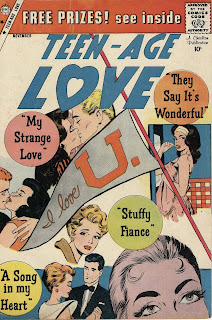The funny animal world has always had its share of bad guys — the hunter who tries to shoot Bugs Bunny, the fox who tries to eat Baby Huey, the Coyote who tries to catch the Road Runner … but for the first few decades of their prominence, the true super villain — that larger-than-life world beater who attempts grand crimes — the equivalent of Doctor Doom or Lex Luthor rare in that genre. It was only when funny animals started having quasi-serious adventure stories, like Walt Disney's Mickey Mouse did in his newspaper comic, that super villains began invading their world.
The Blot, who first appeared in the story that started May 20, 1939, was not the first super villain to menace Mickey. That would probably be Professors Ecks, Doublex and Triplex, whom he encountered in 1933. But he's quite possibly the most-reprinted one, the one who has returned most often, and other than The Brain, the most famous funny animal super villain ever. His story was written by Merrill de Maris (whose other writing credits include the Snow White comics adaptation) and drawn by Floyd Gottfredson (whose fame rests almost exclusively on the Mouse comic). An important supporting character, Police Chief O'Hara, was also introduced in this story.
The Blot's crimes were grander than they looked at first, but not nearly as grand as they later became. But not for a while, at least in America. In Europe, however, especially in stories by cartoonist Romano Scarpa (Uncle Scrooge), he returned frequently. In the U.S., however, he was confined to that one story, which was redone in Dell comic books often enough to become familiar to long-time readers.
First it was reprinted in 1941, as part of the first series of Four Color Comics, the title with rotating stars such as Don Winslow of the Navy and Myra North, Special Nurse. It appeared in the 16th issue, between Tillie the Toiler and Dumbo. Next, the story was re-worked as a serial in Walt Disney's Comics & Stories, again written by De Maris but this time drawn by Dick Moores (Gasoline Alley). It ran from #101 (February, 1949) to #106 (July, 1949). The original version was again reprinted in Mickey Mouse Club Parade #1 (December, 1955), with a new framing sequence by Al Hubbard (Mary Jane & Sniffles).
%20%5BDell%201941%5D%20Mickey%20Mouse%20Outwits%20the%20Phantom%20Blot%20(Sooth)%20-%20Desconocido.jpg)
There have been several latter-day reprints, such as deluxe album editions and hardcover collections of Mickey strips, but those came after The Blot became a recurring villain in America as well as Europe. Walt Disney's Comics & Stories #284 (May, 1964) began a four-part serial titled "The Return of the Phantom Blot" in which he — well, returned. The writer isn't known (but a good guess is Carl Fallberg, co-creator of Space Mouse) and it was drawn by Paul Murry (another who is most famous for Mickey, but who has also done Brer Rabbit and Pluto comics).
Before the year was out, he had his own title. Gold Key's The New Adventures of the Phantom Blot #1 was dated October, 1964. It was part of a minor flurry of Disney villains in their own comics. The Beagle Boys #1 (starring Uncle Scrooge's bad guys) was dated November of that year, and their first issue co-starred Mad Madame Mim. Like other villains in their own comics (such as The Secret Society of Super Villains, which had Captain Comet as a resident hero), The Blot spawned a superhero of his own. In the second issue (April, 1965) long-time Disney star Goofy became Super Goof, in the first of his origin stories (he had several, mutually contradictory).
.jpg)
The Phantom Blot ran seven issues in his own comic, the last one dated November, 1966. By that time, he was firmly established as a recurring villain, and his crimes were quite grand enough to merit his status as a super villain. Since then, he's been back over and over. He's become no less familiar to readers than Spider-Man's Doctor Octopus or Batman's The Joker.
By the way, it's a running schtick that he's never, ever captured and unmasked. He can get killed off, and frequently is (as long as the body isn't recovered), but unmasked, never. He's even been seen with younger relatives, who resemble smaller versions of his cloaked self. But at the very beginning, that trait hadn't been established yet, and, one time only, he was seen without his mask.
Except for his funny-animal dog nose, he looks just like Walt Disney.
Jens Terje offers us the following files:
The Blot´s Double Mystery, German (2013), Italian (1955), English (1988)
3 files
First Blot story - Mickey Mouse Outwits the Phantom Blot (FFC, 1941) & Reprints,
redrawn and other languages
7 files
One-shots, single editions etc.
33 files
There are 43 issues
We thank Jens Terje for this generous contribution













%20(Charlton)%20-%20Desconocido.jpg)
%20(Charlton)%20(c2c)%20-%20Desconocido.jpg)
%20(Charlton)%20(c2c)%20-%20Desconocido.jpg)
%20(Charlton)%20-%20Desconocido.jpg)
%20(Charlton)%20-%20Desconocido.jpg)






























%20%5BDell%201941%5D%20Mickey%20Mouse%20Outwits%20the%20Phantom%20Blot%20(Sooth)%20-%20Desconocido.jpg)
.jpg)



%20619).jpg)
%20614%20-%20Desconocido.jpg)
.jpg)
.jpg)


.jpg)
.jpg)
%20(c2c)%20-%20Desconocido.jpg)
%20-%20Desconocido.jpg)
%20-%20Desconocido.jpg)
%20-%20Desconocido.jpg)
%20-%20Desconocido.jpg)
%20-%20Desconocido.jpg)
.jpg)
%20-%20Desconocido.jpg)
%20-%20Desconocido.jpg)


%20-%20Desconocido.jpg)

.jpg)
%20-%20Desconocido.jpg)
%20-%20Desconocido.jpg)
%20-%20Desconocido.jpg)
